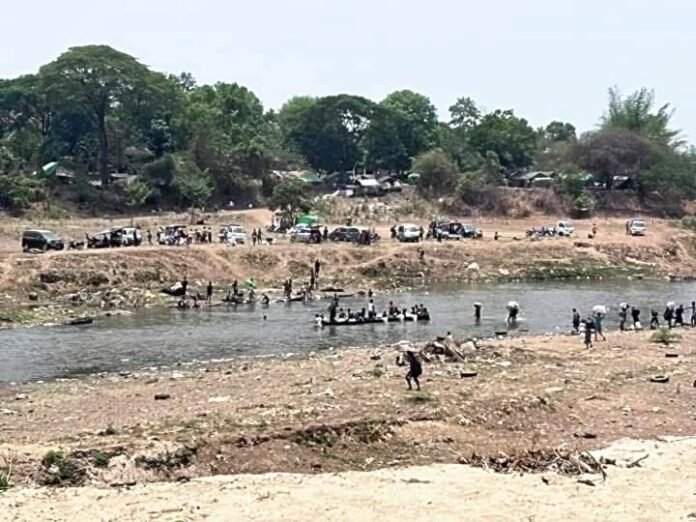People from Myanmar cross a river that runs along the Myanmar-Thailand border as they flee to Mae Sot in western Thailand on April 20.
6:00 JST, May 1, 2024
MAE SOT, Thailand – Six months have passed since large-scale fighting broke out in Myanmar between the country’s military and armed ethnic minority groups. In Myawaddy, a major city near the border with Thailand, fighting rages on as the army and armed groups advance and retreat. Unrest in Myanmar is increasing under the country’s military regime.
‘Because I have a family member who is a soldier, I am always prepared for the worst. But I still can’t believe he’s dead,” said a 34-year-old Myawaddy woman who attended the funeral of her cousin, 39, on Friday, choking back tears.
Her cousin was fighting on the front lines as a member of the pro-democracy forces when he was shot in the neck and killed during a firefight with Myanmar’s military in eastern Kayin state on April 20. Fighting between armed ethnic minority groups and the army has continued for years. After the 2021 coup, pro-democracy armed groups joined the fight on the side of the ethnic minorities.
Residents of Mae Sot in western Thailand, an area close to where the gunfight took place, told The Yomiuri Shimbun that on April 20 they heard continuous gunfire and saw helicopters bombing the area. News of bullets flying towards Mae Sot further exacerbated the situation. situation. The Thai government said about 3,000 Myanmar citizens have fled to Mae Sot to escape the conflict.
In Myanmar’s Kayin state, fighting between the military and resistance has intensified since April. When the Karen National Union, or KNU, an armed group based in the state, declared control of Myawaddy on April 11, the army deployed 1,000 soldiers to the area and launched heavy airstrikes. The April 20 airstrikes killed at least seven civilians, according to The Irrawaddy, a local independent media outlet. The KNU subsequently announced a “temporary withdrawal” from Myawaddy on April 24.
Myawaddy is one of Myanmar’s most important trading centers. “If the KNU can gain full control of Myawaddy, the junta would lose a huge amount of money from trading across the border. Moreover, the junta would be concerned that we would easily obtain weapons,” Saw Taw Nee, a senior KNU official, told The Yomiuri Shimbun. “These may be the reasons why the junta is hitting us hard.”
Large-scale fighting between the military and armed groups erupted on October 27 last year when three armed groups, including the Ta’ang National Liberation Army, based in northeastern Shan State, launched a large-scale attack on the army’s strongholds. Intense fighting spread to other areas in the country, and the conflict continued not only in Kayin state, but also in western Rakhine state and the northwestern city of Sagaing.
The army is plagued by a serious shortage of soldiers due to desertions and other circumstances, causing it to fade into the background in several areas. The military’s announcement in February that it would begin recruiting civilians aged 18 and older has accelerated the exodus from the country.
The number of internally displaced people in the country is also increasing rapidly. According to the UN High Commissioner for Refugees, the number of internally displaced persons has reached 2,658,400 as of April 22, an increase of about 60% compared to October last year.
Thailand alarmed and concerned
Thailand is increasingly concerned about the escalation of fighting near the border with Myanmar.
Thai Prime Minister Srettha Thavisin expressed concern about the border clashes in an April 20 post on X, saying he did not want them to impact Thailand.
On April 23, the Thai government established a special committee to discuss the possible consequences of the situation in Myanmar, including measures for refugees. Foreign Minister Parnpree Bahiddha-Nukara, Interior Minister Anutin Charnvirakul, Defense Minister Sutin Klungsang and others later visited Mae Sot and inspected the border area. The next day, the Thai government proposed that Laos, chairman of the Association of Southeast Asian Nations, hold a special meeting to resolve the Myanmar issue.



